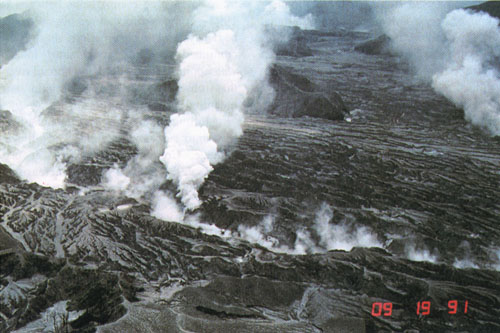
FIRE and MUD: Eruptions and Lahars of Mount Pinatubo, Philippines
Geologists have long known that fresh pyroclastic debris on the slopes of volcanoes will be eroded and transported onto adjoining alluvial fans. In April and May 1991, both the geologic record at Pinatubo and experience at other tropical volcanoes practically shouted that rain-induced lahars (hyperconcentrated streamflows and debris flows) would be major hazards should Pinatubo erupt. But the scales and rates of lahar processes at Pinatubo have surprised even veteran observers.
Pyroclastic flows of June 15, 1991, filled canyons to depths of up to 200 m (typically, 50-100 m) and left nearly flat, featureless landscapes save for a few islands (kipukas) of older terrain whose tops remained unburied. About 5 to 6 km3 of fresh pyroclastic-flow deposit and about 0.5 km3 of tephra-fall deposit rested briefly on Pinatubo's slopes, awaiting heavy typhoon and monsoonal rains. Burial and stripping of vegetation, plus a cover of fine ash, increased runoff dramatically. Rains from Typhoon Yunya during the climactic eruption itself followed in short order by more typhoons and the southwest monsoon, quickly began their work. Drainages were reintegrated within the first 2 months, and more than 0.8 km3 of debris was moved onto the fans within just 3 months. By the end of the second year, lahar deposits exceeded 1.4 km3, and by the end of the third year, about 1.9 km3 had reached the fans. Rates of sediment yield during 1991, as high as 4x106 m3 of sediment per square kilometer of watershed, and as high as 1,600 m3 of sediment per square kilometer per millimeter of rainfall (Janda and others), were an order of magnitude higher than previous records from Mount St. Helens and Sakurajima Volcano; sediment yields in 1992 and 1993, though declining, began to include significant components of pre-1991 debris.
Papers in this volume address only the first 2 to 3 years of posteruption lahars, and thus only the first chapters of the ultimate lahar story. Papers are arranged chronologically, geographically, and topically. Syneruption lahars associated with Typhoon Yunya (Major and others) were followed by other 1991 lahars of the east side (Pierson and others; K.M. Scott and others) and west side (Rodolfo and others; Umbal and Rodolfo). Umbal and Rodolfo describe the evolution and periodic breakout of a lahar-dammed lake on the southwest side of the volcano; Scott and others present channel cross sections that graphically show filling of lowland channels. Differences from one watershed to the next are addressed by several authors.
Papers on 1992 lahars on the east side present results of more systematic monitoring than was possible in 1991. Instrumental monitoring (Marcial and others) included rainfall monitoring and use of acoustic flow monitors (designed by R.G. LaHusen) to quantify lahars. Even relatively light rainfall (0.3-0.4 mm/min for 30 min) triggered lahars in the Sacobia River during 1991 and 1992, and there was an essentially linear relation between rainfall and instrumentally recorded lahar runoff. In addition, both instantaneous and time-integrated records of acoustic flow sensors correlated well with manually observed discharge at nearby observation posts (Tuñgol and Regalado; Martinez and others; Arboleda and Martinez). Cumulative records from the acoustic flow monitors are in remarkably good agreement with postseason measurements of the volume of lahar deposits.
For the west side of Pinatubo, Rodolfo and others make interesting comparisons between lahars of 1991 and 1992--comparisons that are possible because those authors began systematic observations shortly after the eruption and continued them doggedly until lahars threatened their watchpoints late in 1993 and spread over such a broad area that observations from a single streambank became meaningless.
Filling of downstream channels, followed by overbank flow into surrounding fields and villages, caused massive damage. Continued deposition, at progressively higher points on the alluvial fans, is increasing the threat in some drainages that lahars will move into adjoining drainages and threaten towns that to date have still escaped major damage. More than 50,000 persons have been displaced, about 400 km2 of rich agricultural land have been covered, and an even larger area is now flooded during heavy rains or left dry by choking of irrigation canals. Transportation has been disrupted repeatedly, and the specter of further lahars has slowed economic recovery of the area. Indeed, direct and indirect damage from lahars has probably exceeded that from the eruption several times over.

Intricately dissected pyroclastic-flow deposits. Sacobia River.

Two hot lahars, marked by trains of steam plumes, flowing down forks of the Marella River, September 19, 1991.
PHIVOLCS | University of Washington Press | U.S.Geological Survey
This page is <https://pubs.usgs.gov/pinatubo/section7.html>
Contact: Chris Newhall
Last updated 05.07.99